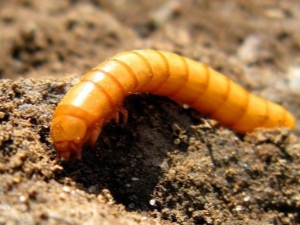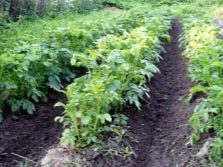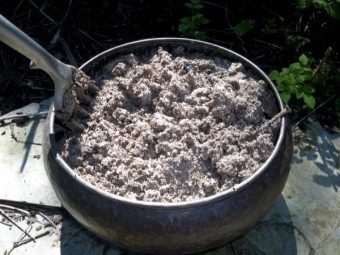How to get rid of the wireworm on the potato plot?

The appearance of the wireworm on the plot is a fairly common and unpleasant phenomenon.Despite the fact that the pest is able to burrow into the ground to a depth of several meters, it is possible and necessary to fight it. The methods of insect extermination are not as varied as the means to fight the Colorado potato beetle, however, there are several effective ways to save the crop.
Pest description
The wireworm is a larva of the click beetle and is a golden or brown worm 1-4.5 cm long. An adult individual is able to lay more than 200 eggs per season, of which the wireworm larvae emerge. The insect belongs to the family Elateridae and is represented by more than 400 genera. Agriotes, Melanotus and Selatosomus are the most common on the Russian territory. Representatives of Athous and Limonius can also be seen on potato fields, but they are much less common than previous species.
A distinctive feature of wireworms is the presence of a hard shell, which is hard enough to crush with fingers, and the presence of powerful nodules, with which the pest can easily cope with the skin of the potato and quickly penetrates inside.
The life cycle of an insect lasts an average of 5 years, four of which the beetle is in the larval stage and requires large amounts of food. The favorite food of the pest are the root systems of many plants and potato tubers. Adult individuals turned into beetles do not pose a threat to potato harvest and feed on cereal leaves.
To distinguish an adult beetle from an insect of another species is quite simple: to do this, it is only necessary to turn the pest backwards and watch its coup back on its belly. In click beetles, a characteristic click is heard, while the other insects turn over silently.
Causes of
With the arrival of spring and the increase in air and soil temperatures, the overwinter clickstalkers begin to move and choose a place to lay eggs. Insects prefer fields and orchards densely planted with potatoes and possessing predominantly acidified soils. The choice of location is primarily due to the fact that the tops of new potatoes are a favorite delicacy of beetles, therefore no gardener is insured against their appearance on the potato field.
Laying eggs by adults occurs in the first decade of June, and after 20 days, the first worms begin to appear from the clutches.
To notice the wireworms is quite difficult. Their presence is often determined by indirect signs, such as the appearance of single lesions of tops, and in some cases its complete withering.
The difficulty of identifying a pest is due to the high vertical migration of worms that can quickly burrow into the ground by 1-2 meters. However, the horizontal migration of insects is not so wide, and is often limited to 20 cm from the bush. This explains the fragmentation of the destruction of the plantation, which is often limited to one or several bushes, and does not extend to the entire field.
What harm does it do?
Wireworms cause significant damage to crops. The first to suffer are potato tubers and young grape shoots. Cereal, solanaceous, cabbage and root vegetables are also often susceptible to the harmful effects of worms. If you do not start timely pest control, the plants stop growing and lose the quality of the fruit.
Two-three-year-old individuals that have reached a size of 2–4 cm bring the maximum damage to crops. Worms of this age already have hard shell, and their coloring has time to change from golden to brown or purple. Wireworms are most active in dry periods. This is explained by the fact that they try to compensate for the lack of moisture in the ground by eating juicy tubers, thereby causing irreparable harm to the plant. Therefore, additional soil moisture sometimes helps to partially reduce damage.
The wireworm is an omnivorous pest, so it affects absolutely everything that can reach: tomatoes, onions, corn and wheat. Moreover, it is not so important to him what stage of growth the culture is at: he will gladly eat both the stem and the fruit.
The big trouble is the fact that the larvae are able to tolerate the winter well and with the appearance of the first shoots actively begin to eat them. Along with mechanical damage to the fruits, the wireworm drains large amounts of nutrients and juices from the plant, and also makes the tubers quite vulnerable to pathogenic microorganisms, rot and mold. In terms of the degree of damage, the wireworm is quite comparable to the main enemy of potato crops, the Colorado potato beetle.
Along with the unconditional harm, the benefits of worms still exist. The pest destroys the root system of weeds, provides soil ventilation, is an important link in the food chain and acts as a catalyst for soil acidity.
Prevention
Unlike the Colorado potato beetle, to identify the wireworm on your site is quite difficult. Therefore, it is sometimes easier to prevent its occurrence than subsequently to fight it. For this, it is necessary to carry out a number of preventive measures, one of which is a competent crop rotation. It is not recommended to plant potatoes at one site for several years. The planting of diverse crops at one place quite noticeably changes the mineral composition of the soil and deprives pests of favorable conditions.
Rapeseed, spinach, phacelia and any kind of legumes are suitable as replacement crops. Another prerequisite is a thorough harvesting. Leaving the tubers in the ground is not recommended. Neglecting this rule provides the wireworm with a comfortable wintering with an adequate supply of food, as a result of which it will be harder to get rid of it.
An important preventive measure is the reduction of soil acidity. Indicator plants growing on the site will help determine the strong acidification. These include horsetail and sorrel. Plantain also loves acidified soils, but can safely grow on soils with low acidity, so you should not be guided by it. Eggshell or chalk will work well as a neutralizer.
The attraction to the site of starlings, thrushes, ravens, tits and turtle doves will help to cope with the invasion of beetles. To do this, you need to build a birdhouse directly near the plantations, or simply feed the birds. A good method of struggle is to populate the field ground beetles. These carnivorous insects are the wireworm's worst enemy and enjoy eating it.
As the simplest protection against pests should regularly deal with the removal of weeds. Especially it is worth paying attention to burdock and couch grass. These plants are a favorite delicacy of both adults and their larvae, and must be destroyed first.
You should also pay attention to the layout of the holes during landing. Potatoes should not be planted too close together. This will provide the necessary distance between neighboring bushes and prevent the transfer of pests from one plant to another. Pre-treatment of soil will help protect the culture from worms.
To do this, add a hot solution of potassium permanganate to the humus and treat the area. The use of mineral fertilizers, which include ammonium sulfate, helps prevent the appearance of wireworms. Deep digging and loosening also prevents the growth and development of the larvae. This is explained by the fact that eggs that were taken to the surface of the earth instantly burn in the sun and turn out to be completely unviable.
Methods of struggle
You can get rid of the wireworm on the potato plot in several ways. The choice remains with the owner of the field and depends on many factors.First of all, this is the area of distribution and the degree of damage to plants, secondly, the presence of certain chemical or biological agents, and thirdly, the type of soil and climatic conditions.
Agrotechnical measures
To agrotechnical methods of pest control include measures that significantly reduce the population of insects without the use of chemicals. The effective method is planting between potato rows of lettuce leaves. The juicy pulp and roots of this plant are very popular with the larvae, which will help to slightly reduce the defeat of the tubers and give hope for the preservation of the harvest. It is also necessary to monitor the condition of the soil.
To normalize the acid-base balance is recommended the use of wood ash. The tool is added to the ground in the process of plowing, digging or directly into each well when planting potatoes. The ash obtained as a result of the burning of potato tops together with the green part of dried sunflower has perfectly proved itself. If self-production of ashes is impossible, the finished product can be bought in specialized stores.
A rather effective way to combat wireworm is planting green mans plants. Their presence adversely affects the growth and reproduction of larvae, in addition, the siderats have a positive effect on the composition of the soil, saturating them with a large number of useful substances. As plant defenders, alfalfa, vetch, lupine and white mustard are mainly planted, of which exactly mustard is the most unpretentious and rapidly growing.
Experienced gardeners conditionally divide the potato field into two parts, one of which is planted with a siderat, and the second - a potato. The following year, the cultures change places. Such agrotechnical technique allows you to quickly get rid of the wireworm and fully preserve the harvest.
The disadvantage of this method is not very rational use of the land, of which half will have to stand idle. However, when growing potatoes in a warm climate zone, the siderat can be planted after harvesting the early ripening varieties. Before the onset of autumn frosts, such plants have time to grow and rid the soil of the larvae. In addition to planting siderats, the neighborhood with spinach, sweet clover, buckwheat, rape, colza and legumes helps to cope with the invasion of wireworm. Especially the larvae do not tolerate the neighborhood with dahlias. In addition, the placement of this beautiful flower in the potato field will completely eliminate the emergence of wheat grass.
Another interesting agrotechnical method is the sowing of baits, which use barley grains, corn, wheat and rye. Seeds that are planted 15 days before the expected planting time for potatoes, have time to germinate a little. The distance between the rows of grain should be 60 cm. Pre-grain should be treated with chemical means "Decis" or "Karate". This will help to subsequently destroy all the pests that feed on young shoots.
After the hungry clicker beetles, together with their larvae, begin to swallow up young shoots with pleasure after hibernation, the soil should be carefully excavated. As a result, digging up the eggs will be on the surface and burn in the sun, and the larvae themselves will die from chemical agents. During the month, the preparations are safely removed from the soil and do not pose a threat to the future harvest.
Chemicals
Despite the fact that the use of chemicals in the fight against wireworms is a fairly effective technique, this method should be applied in cases of extreme necessity. The simplest and most accessible means is superphosphate treated with Decis, Aktellik or Karate.To do this, pour 5 kg of dry matter onto a plastic film, then spray it with a water-acetone solution, in which you need to add one of the aforementioned means. For five kg of superphosphate, it is enough to take 0.8 l of water, 0.2 l of acetone and 4, 15 and 1 ml of chemical preparations, respectively. After complete drying, the granules are scattered on the site by the tape method.
Industrial preparations of the third class of danger, such as "Barguzin", "Pochin" and "Provotoks", should be used in strict accordance with the attached instructions, closely monitoring the dosage and following precautions. It should be noted that the above preparations are completely harmless to bees, therefore, in the immediate vicinity of apiaries, such means can be used without restrictions. Some gardeners consider effective treatment of soil with potassium permanganate. To do this, it is recommended to dilute 5 grams of the substance in 10 liters of water, then pour half a liter into each well when planting.
The solution repels wireworms and has a powerful anti-bacterial effect. A good prevention of the appearance of pests will be the treatment of soil with ammonium sulfate, taken at the rate of 30 g / m2, ammonium chloride, taken at the same concentration, and ammonium nitrate (20 g / m2).
Means "Aktara" and "Prestige" are fairly common drugs and are most often used by summer residents. They are very effective against not only wireworms, but also many other pests, and are not highly toxic.
"Basudin", "Thunder" and "Medvetoks" are considered the most powerful, but at the same time quite toxic and harmful to humans drugs. Their use is advisable only in case of extensive damage to the fields and is justified in cases where other means cannot cope.
Biological agents
It is possible to cope with the wireworm without the use of chemicals. The use of biological agents is absolutely safe for humans and does not cause soil contamination. The simplest method of biological protection against pests is the use of ground eggshell. The mixture unfolds throughout the field during the entire growing season of potatoes and copes well with both the wireworm and other pests.
Nettles or dandelion tinctures, taken in proportions of 500/10 l and 200 g / l, respectively, help well. This volume is usually enough for 20 holes.
Treatment is recommended for a week every other day. Of the finished products well-proven "Nemabak." The tool is a powder containing microscopic nematode worms. When a wireworm is detected, the worms penetrate into its body and devour it from the inside.
Mechanical methods
No less effective is the use of baits from potatoes, carrots and beets. For this, pieces of root crops are added to the depth of 5-15 cm, and their location is marked with rods stuck into the ground. After 3-5 days, the bait with the worms on them should be removed and destroyed by burning or boiling. For ease of use and longer trap life it is recommended to use glass jars. To do this, they are placed in a shaded place, filled with chopped potato tubers and instilled into the neck. Then every two days the bait is taken out of the jar and destroyed along with the worms.
The adult individuals of the wireworm are click beetles, they like to hide in shady and wet places. For their capture and destruction, it is recommended to decompose into shaded areas of a handful of grass or manure, which after 2-3 days should be collected and burned along with the beetles that settled in them.
The procedure should be carried out twice per season - in the fall and in the spring, and in the autumn period the lures are laid out until the onset of cold weather.
Folk remedies
Many gardeners do not welcome the use of chemicals, and use proven over the years folk methods. Cope with the wireworm is well helped by the infusion of celandine, taken at the rate of 100 g per 10 l. This solution should be treated three times the ground, pouring half a liter of the composition under each bush. Between irrigation should take at least 7 days. Using onion peel is also considered quite effective.
To do this, carefully knead the husk to the state of small crumbs and add handful to each well during planting. Not bad helps and the usual salt, which is scattered on the soil before the rain or watering. Penetrating to the roots of the plant, salt destroys the larvae and frees the culture from pests. It is also recommended to plant on the marigold and calendula potato fields.
Useful tips
In order to get rid of the wireworm finally, measures for its destruction should be carried out for six years. Such a long period is due to the fact that several generations of the click beetle live in a certain area. After a single trapping or etching, only adult individuals are killed, and the larvae continue to emerge from the laid eggs, to live and develop fully.
In addition, it must be remembered that in order to enhance the effect and obtain a stable result, it is recommended to combine the methods, use alternately and alternate among themselves. The use of chemicals should be a last resort and be used only when it is no longer possible to remove the pest from the field using gentle methods.
The appearance of the wireworm on the potato field is certainly an unpleasant phenomenon. However, strict adherence to the necessary recommendations and strict adherence to the rules of agricultural engineering will help get rid of the pest and preserve the crop.
For information on how to beat the wireworm, see the next video.










































